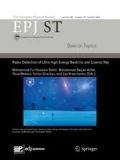Abstract
We address the basic postulates of quantum mechanics and point out that they are formulated for a closed isolated system. Since we are mostly dealing with systems that interact or have interacted with the rest of the universe one may wonder whether a suitable modification is needed, or in order. This is indeed the case and this tutorial is devoted to review the modern tools of quantum mechanics, which are suitable to describe states, measurements, and operations of realistic, not isolated, systems. We underline the central role of the Born rule and and illustrate how the notion of density operator naturally emerges, together with the concept of purification of a mixed state. In reexamining the postulates of standard quantum measurement theory, we investigate how they may be formally generalized, going beyond the description in terms of selfadjoint operators and projective measurements, and how this leads to the introduction of generalized measurements, probability operator-valued measures (POVMs) and detection operators. We then state and prove the Naimark theorem, which elucidates the connections between generalized and standard measurements and illustrates how a generalized measurement may be physically implemented. The “impossibility” of a joint measurement of two non commuting observables is revisited and its canonical implementation as a generalized measurement is described in some details. The notion of generalized measurement is also used to point out the heuristic nature of the so-called Heisenberg principle. Finally, we address the basic properties, usually captured by the request of unitarity, that a map transforming quantum states into quantum states should satisfy to be physically admissible, and introduce the notion of complete positivity (CP). We then state and prove the Stinespring/Kraus-Choi-Sudarshan dilation theorem and elucidate the connections between the CP-maps description of quantum operations, together with their operator-sum representation, and the customary unitary description of quantum evolution. We also address transposition as an example of positive map which is not completely positive, and provide some examples of generalized measurements and quantum operations.
Similar content being viewed by others
References
M. Nielsen, E. Chuang, Quantum Computation and Quantum Information (Cambridge University Press, 2000)
A. Peres, Quantum Theory: concepts and methods (Kluwer Academic, Dordrecht, 1993)
J. Bergou, J. Mod. Opt. 57, 160 (2010)
V. Paulsen, Completely Bounded Maps and Operator Algebras (Cambridge University Press, 2003)
E. Arthurs, J.L. Kelly, Bell. Syst. Tech. J. 44, 725 (1965)
J.P. Gordon, W.H. Louisell in Physics of Quantum Electronics (Mc-Graw-Hill, NY, 1966)
E. Arthurs, M.S. Goodman, Phys. Rev. Lett. 60, 2447 (1988)
H.P. Yuen, Phys. Lett. A 91, 101 (1982)
B. Vacchini, Theoretical foundations of quantum information processing and communication, E. Bruening et al. (eds.), Lect. Not. Phys. 787, 39 (2010)
E. Prugovečki, J. Phys. A 10, 543 (1977)
N.G. Walker, J.E. Carrol, Opt. Quantum Electr. 18, 355 (1986)
N.G. Walker, J. Mod. Opt. 34, 16 (1987)
http://en.wikipedia.org/wiki/Uncertainty_principle
M. Ozawa, Phys. Lett. A 299, 17 (2002)
M. Ozawa, Phys. Rev. A 67, 042105 (2003)
M. Ozawa, J. Opt. B 7, S672 (2005)
J. Preskill, Lectures notes for Physics 229: Quantum information and computation available at www.theory.caltech.edu/∼preskill/ph229/
Depending on the source, and on the context, the theorem is known as the Stinespring dilation theorem, or the Kraus-Choi-Sudarshan theorem
P. Pechukas, Phys. Rev. Lett. 73, 1060 (1994)
R. Puri, Mathematical methods of quantum optics (Springer, Berlin, 2001)
K.E. Cahill, R.J. Glauber, Phys. Rev. 177, 1857 (1969)
K.E. Cahill, R.J. Glauber, Phys. Rev. 177, 1882 (1969)
I. Bengtsson, K. Zyczkowski, Geometry of Quantum States (Cambridge University Press, 2006)
Lectures and reports by C.M. Caves, available at http://info.phys.unm.edu/∼caves/
P. Busch, M. Grabowski, P.J. Lahti, Operational Quantum Mechanics, Lect. Notes. Phys. 31 (Springer, Berlin, 1995)
T. Heinosaari, M. Ziman, Acta Phys. Slovaca 58, 487 (2008)
C.W. Helstrom, Quantum Detection and Estimation Theory (Academic Press, New York, 1976)
A.S. Holevo, Statistical Structure of Quantum Theory, Lect. Not. Phys 61, (Springer, Berlin, 2001)
M. Ozawa, J. Math. Phys. 25, 79(1984)
M.G.A. Paris, J. Rehacek (eds.), Quantum State Estimation, Lect. Notes Phys. 649 (Springer, Berlin, 2004)
V. Gorini, A. Frigerio, M. Verri, A. Kossakowski, E.C.G. Sudarshan, Rep. Math. Phys. 13, 149(1978)
F. Buscemi, G.M. D’Ariano, M.F. Sacchi, Phys. Rev. A 68. 042113 (2003)
K. Banaszek, Phys. Rev. Lett. 86, 1366 (2001)
Author information
Authors and Affiliations
Corresponding author
Rights and permissions
About this article
Cite this article
Paris, M.G.A. The modern tools of quantum mechanics. Eur. Phys. J. Spec. Top. 203, 61–86 (2012). https://doi.org/10.1140/epjst/e2012-01535-1
Received:
Revised:
Published:
Issue Date:
DOI: https://doi.org/10.1140/epjst/e2012-01535-1



